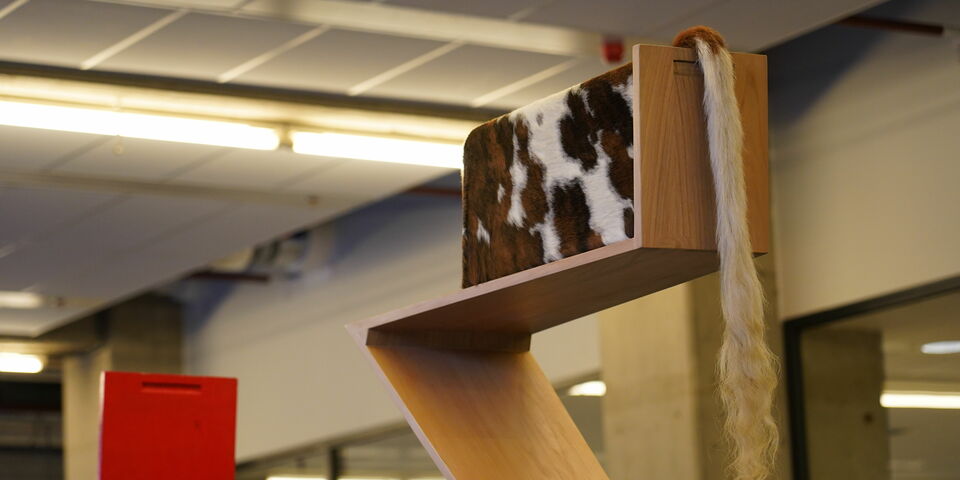‘Koestoel’ returns to its roots in Vertigo
Architect and TU/e alumnus Bert Staal and artist Matty Christensen have donated their ‘Koestoel’ to the university. The ‘cow chair’ was adopted as the mascot of the Eindhoven School movement, the name given to the attitudes and work of a generation of architects who graduated from TU/e in the 1970s. Produced as a TU/e project, the chair is now on display in Vertigo as part of the Ort&Distort exhibition, opened Thursday by the duo and Arie van Rangelrooij.
An elongated zigzag chair with its built-in cowhide ‘cushion’ stands at the head of a copy of a staircase in Vertigo. Its design is based on the world-famous Zig Zag chair (1934) by architect Gerrit Rietveld. Hanging off the rear end of the chair is a cow’s tail. Adding that tail is just the sort of thing an artist would do, says Christensen, who co-designed the Koestoel with Staal. “It creates a cheerful sense of strangeness,” she explains. This is because it appears to be supporting the chair.
Often an element in the work produced by their company buro Staal|Christensen, humor has also played a part in the renovation of the Auditorium building on the campus. Take the oversized pencil that runs alongside the staircase in the Blauwe Zaal, for example. It is a reference to recording knowledge, says Staal. “That’s fundamental to study. Isn’t it nice how people on the staircase stroke the pencil as they pass by?” The Auditorium renovation is one of the projects now on display in Vertigo, as part of the Ort&Distort exhibition. The Koestoel is the exhibition’s centerpiece. Ownership of the artwork passed to TU/e last week when it joined the university’s art collection.
Surrealist
The duo opened the exhibition on Thursday, together with Arie van Rangelrooij, who like Staal was a student at TU/e during the era of the Eindhoven School movement. In a surrealist performance, Staal tried to convince the audience that people only learned how to sit when Rietveld designed his Zig Zag chair. The slides he used to support his theory were projected onto two screens behind him by Christensen. Van Rangelrooij accompanied the performance with a soundscape he had created by taping over the keys of organs and by playing funk piano.
Whether Staal managed to gain converts to his theory of sitting remains open to debate, but his audience certainly found it entertaining. His bizarre narrative seems representative of the work produced by buro Staal|Christensen, which often seeks out contradictions and likes to confuse. “I love to confuse the hell out of myself when I’m working on a design problem, because that’s the only way to come up with something exceptional,” explains Staal. “It mustn’t be predictable.”
From A to B
He learned this way of working at TU/e, he says. “The Eindhoven School taught us not to move from A to B in a straight line, but to take a huge detour. You have to make the search for a solution as wonderful as you can. Your brain needs to be stimulated.” Anything was possible in that era, says Van Rangelrooij. “It was said that no architecture was being produced here, but under the radar a whole slew of highly rated Eindhoven architects gained national prominence. There was a sense of a multitude of diversities coming to the fore. The Eindhoven School was so liberal, nothing was off-limits.”
When it appeared on a poster advertising an exhibition at Zurich’s Institute of Technology in 1991, the Koestoel became a mascot of sorts of the Eindhoven School. Staal and Christensen designed the chair for that event. “Evidently, it was a good example of the attitude to design prevailing at the Eindhoven School, whose teachers at that time were Gerard van Zeijl, Geert Bekaert and their circle,” explains Staal. “That attitude combined poetry from the past, historical references and the ultramodern new.”
Voluptuous
The School also taught its students to reference other works, tells Christensen. “And that’s something we did when we produced the Koestoel. It is a mix of two icons: the voluptuous Le Chaise Longue by Le Corbusier and Rietveld’s rigid Zig Zag chair. And that generates a contradiction.” As Staal says, it was precisely because the chair was so iconic of the Eindhoven School at that time that it ended up travelling from exhibition to exhibition. Now the chair is being given a home in Vertigo. “This is where it belongs because this is where it was created. It sums up the seven years I spent studying here.”
The exhibition Ort&Distort is on display until April 29th in Vertigo.




Discussion